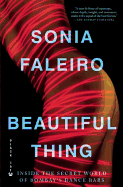
 Beautiful Thing is a portrait that begins in profile: "Leela's face was a perfect heart," Sonia Faleiro writes. "And knowing well the elegance of her little nose, Leela would flaunt it like an engagement ring. On certain evenings at the dance bar, when she needed to increase the padding of hundred rupee notes in her bra, Leela would engage only in silhouette."
Beautiful Thing is a portrait that begins in profile: "Leela's face was a perfect heart," Sonia Faleiro writes. "And knowing well the elegance of her little nose, Leela would flaunt it like an engagement ring. On certain evenings at the dance bar, when she needed to increase the padding of hundred rupee notes in her bra, Leela would engage only in silhouette."
Faleiro met 19-year-old Leela while she was researching an article on Bombay's "bar dancers," the thousands of maltreated, disenfranchised, often alarmingly young girls who make their livings performing for men in dark bars, frequently selling sex at the behest of pimps. The article, deemed "un-newsworthy," went unpublished--but Faleiro, captivated by Leela's irrepressible vitality, knew this proud, independent girl had a story that must be told.
Beautiful Thing is Leela's story, but through her, Faleiro unveils a larger narrative of Bombay's bar dancers and sex workers, one colored by love and violence, glamour and squalor, sex and corruption--and one that reveals the dark heart of Bombay itself. The city (glittering with promises but "toxic, no less than an open wound") and its dance bars attract girls like Leela, who are lured into working "on the line" because of the immediate financial independence it promises. Faleiro discovered that essentially all of these young women were fleeing horrifying home lives rife with every kind of abuse; she recounts that "every one of the bar dancers in Leela's building had either been raped by a blood relative or sold by one." But even though life on the line is a landmine of danger and exploitation, Leela relishes the freedom it seems to allow her.
Faleiro follows Leela through a year of her life--into dance bars, into brothels, into tiny flats cramped with beautiful girls and plastic bags stuffed with gifts from their customers. She meets a vibrant, heartbreaking array of dancers, prostitutes and hijras (physiologically male sex workers who dress and act as women), as well as the pimps, madams, gangsters and corrupt police who govern their lives. Customers and lovers come and go; friendships are intense, rivalries brutal.
Never judgmental or condescending, Faleiro delivers Leela's story with a reporter's distance and a novelist's immediacy. She animates journalistic observations with vivid descriptions, and her dialogue sings with slang and dialect. Leela moves through the pages as a remarkable, tragic and inspiring figure--victim, heroine, survivor. --Hannah Calkins
Shelf Talker: Sonia Faleiro's portrait of one Bombay bar dancer tells an undeniably tragic but grittily inspiring story of thousands of girls like her.

